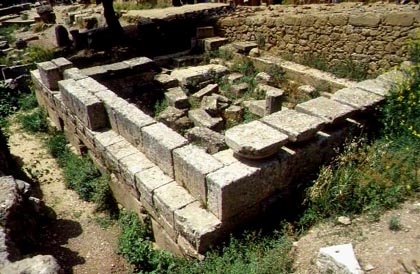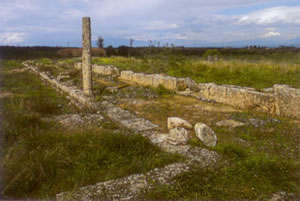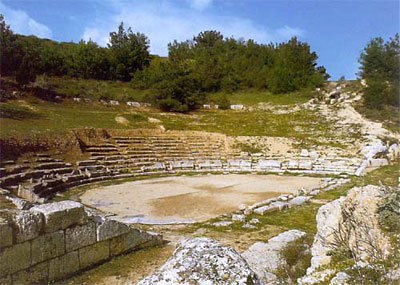A fertile valley, at the area where nowadays Kiato city is located, was the

The treasure of Sikion in Delphi
Sikion field during ancestry and it was a part of the ancient Sikion state. The most important evidence of the prosperity of Sikion was the thesaurus it founded in Delphi in the 5th century. Sikion had also a glorious past and it can be proven thanks to a round stone-made monument where people had place a valuable dedicative item made of bronze to memorize Cleisthenes’s victory in Pythiada, in 582 BC.
Sikion city was built in the green valley between Kiato and Vassiliko but Demetrios the Besieger, who dominated that area in 303 BC, considered that the city was vulnerable. So, he transferred it to a higher point over the bed of Asopos river, which had been used as an acropolis previously. Some sanctuaries and farms had already been built on that upland since the archaic era.
Demetrios took care of the fortification of the city and built the public buildings that were necessary in order to make the habitants’ setting to the city even easier. Even though he tried to rename the city after himself, the habitants finally kept the old name, Sikion.
The Agora of Sikion
The modern village Sikiona was called Vasisiliko in the past and it is located at the same area as Sikion town was located during Hellenistic Era. It can be accessed from Kiato city through a public road which passes through modern Sikion firstly and then it reaches the remains of Hellenistic Sikion to the west.
A roman bath built of the typical bricks used during the post-roman years has been excavated in that area. After repairing, nowadays, it has been turned to a museum. The Agora of the Hellenistic town was located opposite the bath. The foundations of a very long temple (38 m length X 11.3 m width) have been found there. Big length was a typical characteristic of pre-classical temples so it is considered to belong to the archaic era. It must have been reconstructed during the foundation of Hellenistic Sikion.
The foundations of a big square building (40.5 X 41.15) were excavated to the south. The roof was supported by sixteen columns erected inside the building. Possibly, it was used as the Vouleftirion initially (the speakers’ podium had been placed in the middle of the building), yet it was used as a bath afterwards.
A big arcade was found to the east of the previous building, which was 106 m long and 6 m wide. Its façade consisted of 47 doric columns and its inner side consisted of 24 ionic columns. In the bottom, there were 20 homeomorphous rooms used as stores.
Gymnasium of Sikion

Sikion Gymnasium
A big Gymnasium was excavated to the west of the central Agora. This isconsidered to have been founded by Cleinias, Aratos’s father. It consists of two flat rectangle areas, one lower than the other. The upper area (70m X 32.5m) must have been an adjunct to the lower. Arcades had been erected along its northern, western and southern sides. A stair had been built in the middle of the eastern side. The stair was used in order to get from the upper to the lower area which was spacious and where the main Gymnasium area was located. An earth restraining wall had been built along that side, with a stair in the middle of it. Arcades open to the central area and rooms to the back had also been built along the rest sides of the lower area.
Ancient Theatre of Sikion

Sikion Theatre
The theatre was found some meters away from the gymnasium. It is the second most imposing building found in Sikion, after the roman bath. Two stone passages with long roofs, one opposite the other, have survived in a very good condition. The first is located to the north of the koilon and the second is located to the south. They were used to get from the slope hill to the diazomas of the upper gradines. The excavations have brought to light the foundations of the scene, the elevations of the two parodos, the lower gradines and the semi-circular orchestra.
Stadium of Sikion
The stadium area can be seen to the north-west side of the theatre. A pig part of the elevation of the berm has survived nowadays. It is a tall polygonica wall. An upland over the Theatre and the Stadium was used as the acropolis of Hellenistic Sikion and during the roman years sanctuaries dedicated to the goddess Luck and to Dioskouroi had been erected there.
